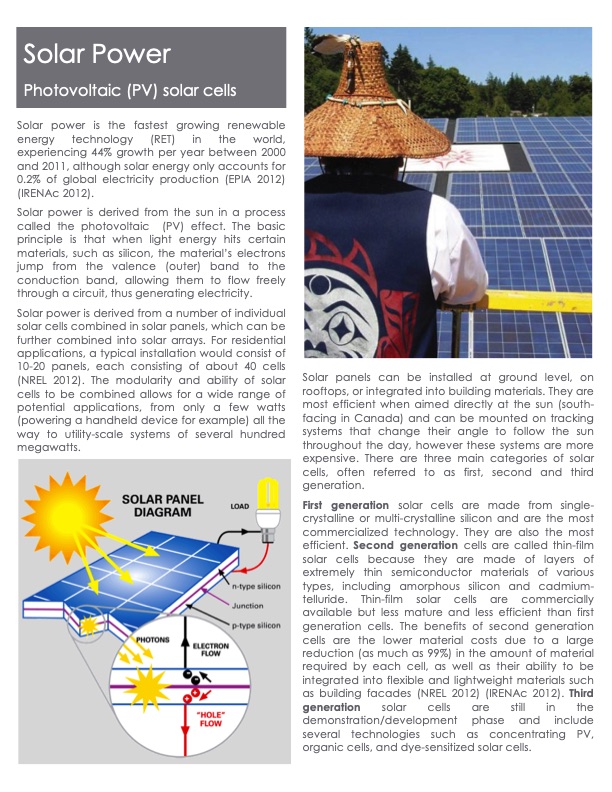
PDF Publication Title:
Text from PDF Page: 005
Solar Power Photovoltaic (PV) solar cells Solar power is the fastest growing renewable energy technology (RET) in the world, experiencing 44% growth per year between 2000 and 2011, although solar energy only accounts for 0.2% of global electricity production (EPIA 2012) (IRENAc 2012). Solar power is derived from the sun in a process called the photovoltaic (PV) effect. The basic principle is that when light energy hits certain materials, such as silicon, the material’s electrons jump from the valence (outer) band to the conduction band, allowing them to flow freely through a circuit, thus generating electricity. Solar power is derived from a number of individual solar cells combined in solar panels, which can be further combined into solar arrays. For residential applications, a typical installation would consist of 10-20 panels, each consisting of about 40 cells (NREL 2012). The modularity and ability of solar cells to be combined allows for a wide range of potential applications, from only a few watts (powering a handheld device for example) all the way to utility-scale systems of several hundred megawatts. Solar panels can be installed at ground level, on rooftops, or integrated into building materials. They are most efficient when aimed directly at the sun (south- facing in Canada) and can be mounted on tracking systems that change their angle to follow the sun throughout the day, however these systems are more expensive. There are three main categories of solar cells, often referred to as first, second and third generation. First generation solar cells are made from single- crystalline or multi-crystalline silicon and are the most commercialized technology. They are also the most efficient. Second generation cells are called thin-film solar cells because they are made of layers of extremely thin semiconductor materials of various types, including amorphous silicon and cadmium- telluride. Thin-film solar cells are commercially available but less mature and less efficient than first generation cells. The benefits of second generation cells are the lower material costs due to a large reduction (as much as 99%) in the amount of material required by each cell, as well as their ability to be integrated into flexible and lightweight materials such as building facades (NREL 2012) (IRENAc 2012). Third generation solar cells are still in the demonstration/development phase and include several technologies such as concentrating PV, organic cells, and dye-sensitized solar cells.PDF Image | Biomass Conversion Technologies

PDF Search Title:
Biomass Conversion TechnologiesOriginal File Name Searched:
Summary_Guide_to_Technologies_Considered.pdfDIY PDF Search: Google It | Yahoo | Bing
NFT (Non Fungible Token): Buy our tech, design, development or system NFT and become part of our tech NFT network... More Info
IT XR Project Redstone NFT Available for Sale: NFT for high tech turbine design with one part 3D printed counter-rotating energy turbine. Be part of the future with this NFT. Can be bought and sold but only one design NFT exists. Royalties go to the developer (Infinity) to keep enhancing design and applications... More Info
Infinity Turbine IT XR Project Redstone Design: NFT for sale... NFT for high tech turbine design with one part 3D printed counter-rotating energy turbine. Includes all rights to this turbine design, including license for Fluid Handling Block I and II for the turbine assembly and housing. The NFT includes the blueprints (cad/cam), revenue streams, and all future development of the IT XR Project Redstone... More Info
Infinity Turbine ROT Radial Outflow Turbine 24 Design and Worldwide Rights: NFT for sale... NFT for the ROT 24 energy turbine. Be part of the future with this NFT. This design can be bought and sold but only one design NFT exists. You may manufacture the unit, or get the revenues from its sale from Infinity Turbine. Royalties go to the developer (Infinity) to keep enhancing design and applications... More Info
Infinity Supercritical CO2 10 Liter Extractor Design and Worldwide Rights: The Infinity Supercritical 10L CO2 extractor is for botanical oil extraction, which is rich in terpenes and can produce shelf ready full spectrum oil. With over 5 years of development, this industry leader mature extractor machine has been sold since 2015 and is part of many profitable businesses. The process can also be used for electrowinning, e-waste recycling, and lithium battery recycling, gold mining electronic wastes, precious metals. CO2 can also be used in a reverse fuel cell with nafion to make a gas-to-liquids fuel, such as methanol, ethanol and butanol or ethylene. Supercritical CO2 has also been used for treating nafion to make it more effective catalyst. This NFT is for the purchase of worldwide rights which includes the design. More Info
NFT (Non Fungible Token): Buy our tech, design, development or system NFT and become part of our tech NFT network... More Info
Infinity Turbine Products: Special for this month, any plans are $10,000 for complete Cad/Cam blueprints. License is for one build. Try before you buy a production license. May pay by Bitcoin or other Crypto. Products Page... More Info
| CONTACT TEL: 608-238-6001 Email: greg@infinityturbine.com | RSS | AMP |